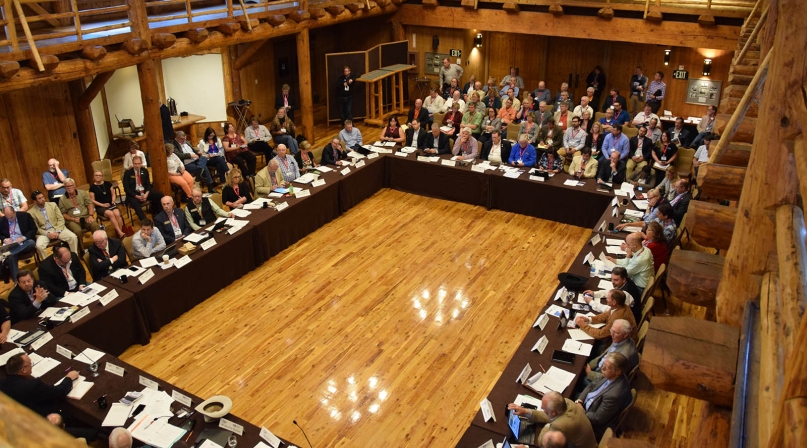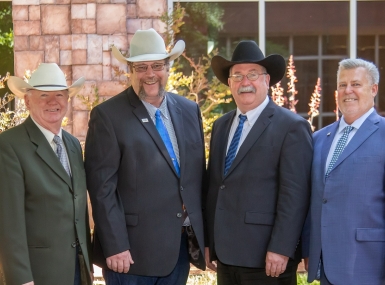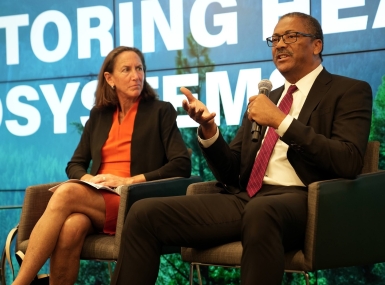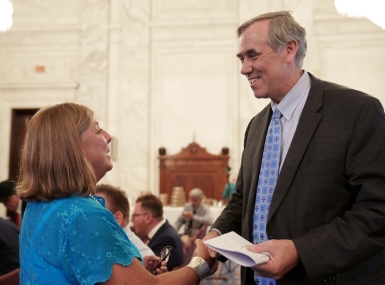New administration means new opportunities for WIR

WIR sees good signs in Trump Administration's executive orders relating to Water of the US, Planning 2.0
The change in the White House is giving counties in Western states a chance to assert their interests and priorities as the Washington establishment resets itself for the first time in eight years, which was both reassurance and a challenge at the Western Interstate Region’s (WIR) conference, held May 23–26 in Deschutes County (Sunriver), Ore.
Even though President Trump’s budget proposal, released a day before the WIR business meeting, called for the elimination of the Secure Rural Schools Act and cuts to Medicaid and Payment in Lieu of Taxes (PILT) funding — all of which would hurt public lands counties if enacted — his administration’s repeal of the “Waters of the U.S.,” the Bureau of Land Management’s Planning 2.0 rule and use of the Congressional Review Act are inspiring optimism. So, too, is Interior Secretary Ryan Zinke’s review of the Antiquities Act of 1906, which has been accompanied by indications that local input will be stressed in future federal decisions on public lands.
“As I have talked about Planning 2.0, and your effort to have it repealed, the administration has stressed the importance of county government and local government and I think you are seeing that from Secretary Zinke’s philosophy,” said Cynthia Moses-Nedd, the Department of Interior’s liaison to NACo.
But even with those early victories, county officials were implored throughout the conference to actively communicate their needs to the federal government, while there was a chance to get in close to the ground floor.
“It’s up to us,” said Robert Cope, past WIR president and a former Lemhi County, Idaho commissioner. “What we cannot do, what we can’t afford to do, is sit in the courthouse and wait for the agencies to come to us and say ‘come coordinate.’ That’s going to get you a dead end 100 percent of the time.”
WIR First Vice President Tommie Cline Martin agreed.
“Me thinks there’s great chaos going on in D.C. and opportunity is greatest in an area of great chaos,” she said in a meeting of the Public Lands Steering Committee. “And we can turn that to our advantage.”
No changes in leadership
The WIR executive committee remained largely the same, with Joel Bousman, a Sublette County, Wyo. commissioner, starting his full term as president; Martin, a supervisor in Gila County, Ariz., serving as first vice president; and Mariposa County, Calif. Supervisor Kevin Cann’s serving as second vice president. Gordon Cruikshank, commissioner, Valley County, Idaho, is the immediate past president.
Other highlights
Host Deschutes County showed off how it had transformed its economy from a resource-dependent logging center to a tourism and home-building powerhouse, with special attention paid to the local rise in craft beer brewing.
Conference workshops focused on wildfire prevention partnerships, essential service sharing, how counties do business with residents who rely on cash, which will increase as the cannabis industry develops.
Others sessions addressed how counties could best plan around the large amount of public land in their borders and how renewable energy generation could be the key to a growing job market, and how the changes in the National Flood Insurance Program could affect counties.
Attendees heard from a variety of Western leaders during general sessions, including Oregon Secretary of State Dennis Richardson, former Wyoming Gov. Jim Geringer, former Rep. Mary Bono (R-Calif.) and former Harney County, Ore. Judge Steve Grasty.
Oregon Secretary of State Richardson said the best way to regain public trust after the divisive 2016 election, was with transparency and accountability, and that was best done with expanded voting access.
He touted Oregon’s vote-by-mail system and laws that extended the lifetime of a voter’s registration, which he said 60,000 voters took advantage of in the last election.
“These are individuals who otherwise would not have voted,” he said.
“It’s an opportunity to try and show people that government is working for them.”
Geringer, who is now director of policy and public strategies for the Environmental Systems Research Institute at Esri, talked about the difference that GIS made for him in state government in a way that paper documents could not, remarking that information on paper is often obsolete before it reaches you.
“Visualization provides context for how you explain something,” he said. “It’s a platform for decision makers and for information integration.”
Bono, who served five terms in the House, recounted when the opioid epidemic became personal for her.
Her son called her while he was at college and told her he was addicted to painkillers.
“He said, ‘my friends and I all thought pills were the safe drug,’” she said.
“‘They came in bottles with a doctor’s name on them. We weren’t doing methamphetamine or cocaine.’”
She praised local efforts, singling out Lake County, Ill.’s program that refers addicts to counseling rather than prosecution.
Next year’s WIR conference will be held May 22–25 in Blaine County (Sun Valley), Idaho.



